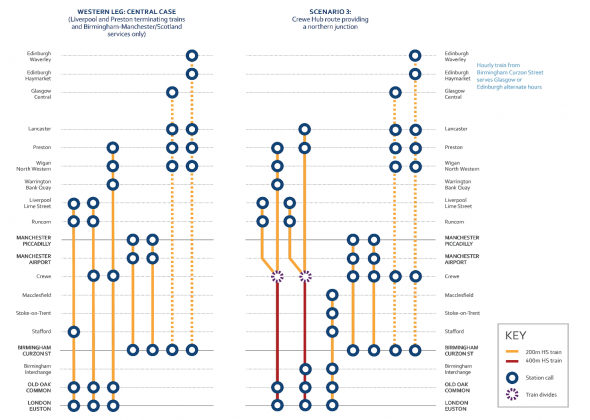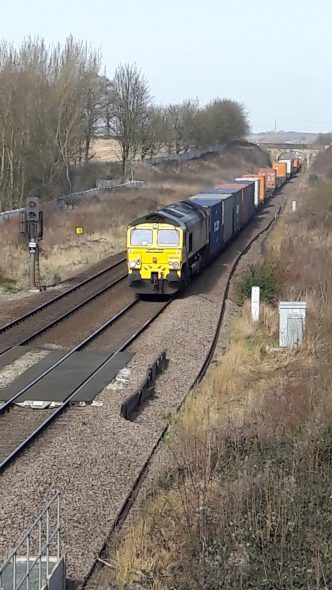The Government’s announcements of July 17th commit £6.6bn to the construction of the Phase 1 scheme that gained Parliamentary powers earlier this year. The seven contracts that have been let cover civil engineering over the length of the Phase 1 route, from detailed design to construction, including major tunnelling works. Contracts for rolling stock, systems, power supply and stations – for which invitations to tender documents have already been released – will follow.
At a time of economic weakness, these commitments represent a very significant boost to the national economy, with an expectation of 16,000 jobs. Sixty percent of jobs are expected to go to SMEs across Britain.
But that’s not all. The Parliamentary Bill for Phase 2a – covering the route from Lichfield to Crewe -was published and the routes for Phase 2b to Manchester, Leeds and other northern destinations were also confirmed on July 17th.
The great news is that we can now speak of HS2 serving Manchester, Leeds and Sheffield in the North following confirmation of the revised Phase 2b alignment. A key aspiration of the Northern Powerhouse – to shrink the travel times between major cities – will be delivered by HS2, with a 30-minute journey time between Leeds and Sheffield.
The unshaken resolve of the Government to proceed is a signal of the determination to improve accessibility for the North and the Midlands. A separate paper emphasises that by 2027, London-Glasgow rail journey times will be cut by 45 minutes. In his statement to the House, the Secretary of State said:
“we will continue to work with Transport Scotland and Network Rail to look at the best ways of further reducing times, towards an ultimate ambition of a three-hour journey time between London and Scotland. We are also looking at opportunities to use HS2 to support Northern Powerhouse Rail and Midlands Connect.”
Along with the headline statements came a plethora of supporting documents. These reveal that the overall investment case remains ‘good’: economic benefits are double project costs. They also show the very detailed consideration that has been given to refining the Phase 2 alignments following consultation.
Phase 2a Lichfield – Crewe
For Phase 2a, there are two key changes:
- A revised alignment on the approach to Crewe
- The re-siting of the infrastructure maintenance facility from Basford Hall, Crewe to near Stone in Staffordshire – a facility that will also be able to serve as a key construction site.
No decision has yet been taken on the investment needed to create the Crewe ‘Hub’ for which a consultation has been launched. Assuming the Hub proceeds, it will be fashioned from an upgrade and rebuild of Crewe station on its existing site, rather than at a greenfield location to the south. This is the right approach, ensuring that the excellent rail connectivity that Crewe currently enjoys can feed directly into HS2.
The supporting documents also provide a useful insight into emerging thinking on revisions to HS2 service plans. The design of Phase 2a provides for use of the connection at Handsacre between HS2 and the West Coast Main Line (WCML) to provide access not just to Stafford, but also Stoke-on-Trent and Macclesfield – places that may now be able to enjoy HS2 services.
This entails adding an HS2 train path to London, facilitated by combining into a single train path south of Crewe services to Preston and Liverpool, with trains dividing and joining at the new Crewe station. This serves to highlight the importance of making the rights choices for Crewe hub, the benefits of which are substantial, offering:
- The opportunity to add an HS2 service to Stoke-on-Trent
- The scope to speed up Liverpool services (which would use the new Phase 2a infrastructure twice hourly and no longer be diverted back onto the slower WCML)
- The scope to ensure that HS2 services from north of Crewe are able to call at the hub station from 2027 onwards.
In fact, the Secretary of State committed to Stoke-on-Trent getting an HS2 service when speaking in the House of Commons in the evening of July 17th.
A candidate revised HS2 service plan is provided in the supporting papers. One of the options – ‘Scenario 3’ – is shown on the right-hand side of the diagram below; the left-hand side shows the reference case, with previous HS2 service assumptions in the Crewe area, and no services to Stoke-on-Trent.

Source: Crewe Hub Consultation, July 2017
Phase 2b to Manchester, Leeds and the North
Following a lengthy period of consultation, detailed changes have been made to the Phase 2b route in a number of areas. In each of these cases, HS2 Ltd has looked hard at the detailed impacts on local communities and the environment before putting forward recommendations for ministerial decisions. The key impacts in terms, for instance, of numbers of properties of different types affected by the alignment options, are spelt out in full.
In the north west, the refinements to alignments are:
- Near Middlewich, to provide a more secure route in terms of geology – this is an area with major historic salt workings
- On the approaches to Manchester Piccadilly.
Over the longer eastern limb through the East Midlands to Yorkshire, the changes affect a much greater length of route, with the adoption of the more easterly alignment that partly follows the M18 motorway across South Yorkshire. From this alignment, instead of a route via Meadowhall that it is now accepted has a number of problems, branches and junctions will be built as part of the Phase 2b scheme to reach Sheffield. This includes a commitment to build a junction near Clayton so that a fast Leeds – Sheffield service can be operated. While not in the written statement, the route from Sheffield Midland north to Leeds “will be electrified to ensure that through services can run to Leeds” (as well as southwards from Sheffield Midland via Chesterfield to the HS2 connection), as was confirmed in an oral answer by the Secretary of State in the House of Commons later the same day. There is also a possibility still being examined to build a parkway station in South Yorkshire on the ‘M18’ alignment.

The existing railway near Clayton where the revised HS2 route will form a junction.
Photo: Greengauge 21
There are also a series of important refinements to the route in the East Midlands, especially near Measham, East Midlands Airport and Long Eaton.
Overall, the Phase 2 selected alignments form an excellent basis to proceed, with the opportunity to add a number of crucial connections to the existing rail network in due course. Finalising how HS2 can best interface with Transport for the North’s plans for the Northern Powerhouse and with Midland Connect’s aims for better east west city to city connectivity, remain as outstanding tasks.
Greengauge 21
© July 2017, Greengauge 21, Some Rights Reserved: We actively encourage people to use our work, and simply request that the use of any of our material is credited to Greengauge 21 in the following way: Greengauge 21, Title, Date
